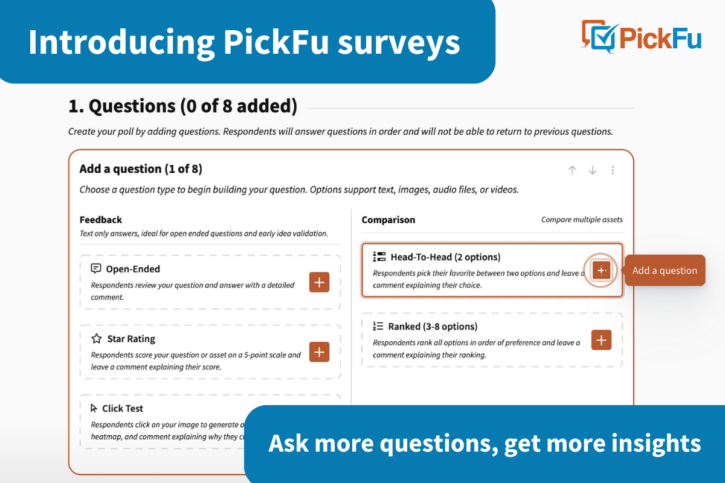One of our most-requested features from customers has been the ability to ask the same audience multiple questions.
So we’re excited to launch multi-question surveys to all PickFu users!
Now you can try our easy-to-use survey builder to:
- Ask up to eight questions
- Mix and match question formats
- Choose one target audience to answer all questions
After your audience completes the survey, you’ll be able to view and analyze results for each individual question – including votes, written comments, demographic reports, and AI-generated summaries and sentiment reports.

Why should I run a survey?
Sometimes, a single-question poll is enough to get the insights you need. Other times, you might have more questions or need deeper context from the same audience.
Here are the benefits of running a multi-question survey:
- Gain clarity, context, and in-depth feedback by asking the same consumer panel multiple questions about your product, brand, or offering
- Speed up your consumer research with the same easy setup and fast results – without having to run separate, individual polls
- Act on high-quality quantitative & qualitative data, including written comments, demographic reports, and AI summaries with every question
When should I run a survey?
Here are a few scenarios where a survey might be a better option than a single poll:
Whenever you need to ask more than one question or touch on more than one topic in your test. If you want to ask a controlled panel a list of questions about your product or solution, we suggest using a survey.
By presenting multiple questions in a row, surveys provide respondents with context, allowing them to consider their answers in relation to the previous questions. In contrast, single-question polls are best for testing one specific aspect and getting clear, focused answers.
When doing comparative analysis. If you need to compare different aspects or features of a product/service, surveys are ideal. You can design questions to assess satisfaction levels, price sensitivity, brand perception, and more, allowing for comprehensive comparative analysis.
When exploring complex topics that require subtle understanding. For instance, when researching consumer behavior towards a new product or exploring new target audiences/markets, multiple questions can help uncover perceptions, preferences, usage patterns, and purchase intentions based on each respondent’s buying behavior.
Survey example: Amazon listing audit
Let’s walk through this PickFu survey example auditing an Amazon listing for a peat moss/compost spreader. The target audience is a group of 15 U.S.-based respondents who live in houses.

Question 1 purpose: Evaluate what’s most important to buyers when shopping for the product. What are they looking for?
Question type: Open-Ended
Respondent comments:
- “I would be looking for weather-proof material. I want it to last more than one season. And I would need a certain mesh. One that doesn’t let out too much particulate at a time. I would prefer a spreader from a trusted brand.”
- “First thing I would be conscious of would be the price on this item, and I would want to know what the weight is because if I can’t push it or if it’s too difficult to push for me, I don’t think it would do me any good.”
- “I’m looking for the durability of the metal that it comes with, quality materials, how well it can spread compost vs other options.”

Question 2 purpose: Search results page analysis. Show the product against several competitors on an Amazon search results page, and ask the audience which product they are most likely to buy.
Question type: Click Test
Respondent comments:
- “In the title, it says two of the important things I am looking for like durability and lightweight. Without anymore information than the titles and photos and prices, it is what I’d go for.”
- “I might look into this option for a few reasons. One, the price seems reasonable. I like feeling like I am getting a good deal when shopping. Two, it looks durable. And three, it looks like a popular product. There’s a reason products are best sellers. Usually worth buying.”
- “I liked that this option looks more classy with its solid black color. It’s also a good balance in terms of price (it’s in the middle mark between the very expensive $179.99 option and the cheaper $42.99 option).”
Question 3 purpose: Product image comparison. Which product images do the best job at convincing shoppers to buy?
Question type: Ranked
Respondent comments:
- “I think the dimensions of the product is important information, with how the product works behind it slightly.”
- “I like the exact specifications shown in the image. I’m not particularly interested in being shown images of what it works with (e.g. dirt.) If I need those I can google them on my own.”
- “Option A is the most important. I need to know what it spreads. If it doesn’t do what I need it for, then the dimensions are useless.”

Question 4 purpose: Get ideas for improving the Amazon listing. Share the link to the product’s live listing and ask the audience what questions they have after viewing it.
Question type: Open-Ended
Respondent comments:
- “Why should I buy from this company over other brands? What makes this spreader better? How much does it weigh?”
- “How maneuverable is the product? Does it turn easily?”
- “Important thing I’d want to know is why it’s so high priced. It doesn’t seem to do anything different than the cheaper ones did, and the bright green color is almost off-putting to me.”
How to get started with PickFu surveys
Ready to run your first survey? Here’s how to get started:
- Log in to your PickFu account (or sign up for free)
- Click the “New poll” button in the top right corner
- Select “Build a survey”
From there, you’ll be guided through the process of adding up to eight questions, selecting your target audience and demographic questions, and checking out.
If you have questions, check out this FAQ article or reach out to our Customer Success team anytime – we’re happy to help.



